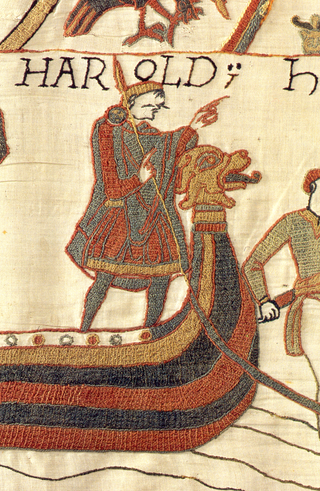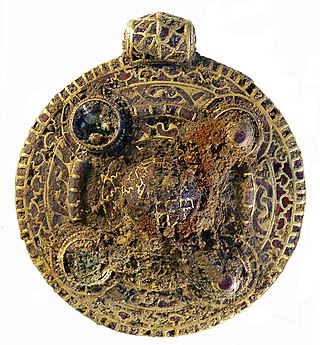
Sutton Hoo is the site of two Anglo-Saxon cemeteries dating from the 6th to 7th centuries near Woodbridge, Suffolk, England. Archaeologists have been excavating the area since 1938, when an undisturbed ship burial containing a wealth of Anglo-Saxon artifacts was discovered. The site is important in establishing the history of the Anglo-Saxon kingdom of East Anglia as well as illuminating the Anglo-Saxons during a period which lacks historical documentation.
The Prittlewell royal Anglo-Saxon burial or Prittlewell princely burial is a high-status Anglo-Saxon burial mound which was excavated at Prittlewell, north of Southend-on-Sea, in the English county of Essex.

Grave goods, in archaeology and anthropology, are items buried along with a body.

Trumpington is a village to the south of Cambridge, in the Cambridge district, in the county of Cambridgeshire, England. The village is an electoral ward of the City of Cambridge and a ward of South Cambridgeshire District Council. The 2011 Census recorded the ward's population as 8,034.

The Museum of Archaeology and Anthropology, also known as MAA, at the University of Cambridge houses the university's collections of local antiquities, together with archaeological and ethnographic artefacts from around the world. The museum is located on the university's Downing Site, on the corner of Downing Street and Tennis Court Road. In 2013 it reopened following a major refurbishment of the exhibition galleries, with a new public entrance directly on to Downing Street.

Helen Mary Geake is a British archaeologist and small finds specialist. She was one of the key members of Channel 4's long-running archaeology series Time Team.

Anglo-Saxon dress refers to the clothing and accessories worn by the Anglo-Saxons from the middle of the fifth century to the eleventh century. Archaeological finds in Anglo-Saxon cemeteries have provided the best source of information on Anglo-Saxon costume. It is possible to reconstruct Anglo-Saxon dress using archaeological evidence combined with Anglo-Saxon and European art, writing and literature of the period. Archaeological finds have both supported and contradicted the characteristic Anglo-Saxon costume as illustrated and described by these contemporary sources.

Ixworth is a village and civil parish in the West Suffolk district of Suffolk, England, 6 miles (9.7 km) north-east of Bury St Edmunds on the A143 road to Diss and 9 miles (14 km) south-east of Thetford. The parish had a population of 2,365 at the 2011 Census.

The Staffordshire Hoard is the largest hoard of Anglo-Saxon gold and silver metalwork yet found. It consists of almost 4,600 items and metal fragments, amounting to a total of 5.1 kg (11 lb) of gold, 1.4 kg (3 lb) of silver and some 3,500 pieces of garnet cloisonné jewellery. It is described by the historian Cat Jarman as "possibly the finest collection of early medieval artefacts ever discovered".

The Sutton Hoo purse-lid is one of the major objects excavated from the Anglo-Saxon royal burial-ground at Sutton Hoo in Suffolk, England. The site contains a collection of burial mounds, of which much the most significant is the undisturbed ship burial in Mound 1 containing very rich grave goods including the purse-lid. The person buried in Mound 1 is usually thought to have been Rædwald, King of East Anglia, who died around 624. The purse-lid is considered to be "one of the most remarkable creations of the early medieval period." About seven and a half inches long, it is decorated with beautiful ornament in gold and garnet cloisonné enamel, and was undoubtedly a symbol of great wealth and status. In 2017 the purse-lid was on display at the British Museum.

The Taplow Barrow is an early medieval burial mound in Taplow Court, an estate in the south-eastern English county of Buckinghamshire. Constructed in the seventh century, when the region was part of an Anglo-Saxon kingdom, it contained the remains of a deceased individual and their grave goods, now mostly in the British Museum. It is often referred to in archaeology as the Taplow burial.
Burial in Anglo-Saxon England refers to the grave and burial customs followed by the Anglo-Saxons between the mid 5th and 11th centuries CE in Early Mediaeval England. The variation of the practice performed by the Anglo-Saxon peoples during this period, included the use of both cremation and inhumation. There is a commonality in the burial places between the rich and poor – their resting places sit alongside one another in shared cemeteries. Both of these forms of burial were typically accompanied by grave goods, which included food, jewelry, and weaponry. The actual burials themselves, whether of cremated or inhumed remains, were placed in a variety of sites, including in cemeteries, burial mounds or, more rarely, in ship burials.
A bed burial is a type of burial in which the deceased person is buried in the ground, lying upon a bed. It is a burial custom that is particularly associated with high-status women during the early Anglo-Saxon period, although excavated examples of bed burials are comparatively rare.

The Street House Anglo-Saxon cemetery is an Anglo-Saxon burial ground, dating to the second half of the 7th century AD, that was discovered at Street House Farm near Loftus, in the unitary authority of Redcar and Cleveland, England. Monuments dating back as far as 3300 BC are located in the vicinity of the cemetery, which was discovered after aerial photography revealed the existence of an Iron Age rectangular enclosure. The excavations, carried out between 2005 and 2007, revealed over a hundred graves dating from the 7th century AD and the remains of several buildings. An array of jewellery and other artefacts was found, including the jewels once worn by a young high-status Anglo-Saxon woman who had been buried on a bed and covered by an earth mound.

The Shorwell helmet is an Anglo-Saxon helmet from the early to mid-sixth century AD found near Shorwell on the Isle of Wight in southern England. It was one of the grave goods of a high-status Anglo-Saxon warrior, and was found with other objects such as a pattern-welded sword and hanging bowl. One of only six known Anglo-Saxon helmets, alongside those found at Benty Grange (1848), Sutton Hoo (1939), Coppergate (1982), Wollaston (1997), and Staffordshire (2009), it is the sole example to derive from the continental Frankish style rather than the contemporaneous Northern "crested helmets" used in England and Scandinavia.
Shrubland Hall Anglo-Saxon cemetery is a 7th-century Anglo-Saxon burial site discovered at Shrubland Hall Quarry near Coddenham, Suffolk. The cemetery contains fifty burials and a number of high-status graves including "the most complicated Anglo-Saxon bed ever found." Bed burials, in which a female body is laid out on an ornamental wooden bed, usually accompanied by jewellery, are rarely found, and are considered of national importance. Only 13 bed burials have been found to date in the UK. The bed burial was one of two graves at the cemetery which were found within wooden-lined chambers. The second chamber contained a male skeleton with grave goods including a seax, a spear, a shield, an iron-bound wooden bucket, a copper alloy bowl and a drinking horn.

The Kingston Brooch is the largest known Anglo-Saxon composite brooch, and is considered by scholars to be an outstanding example of the composite disc brooch style. Over time, the Kingston brooch has become widely recognized for its charm, inherent value and detailed workmanship. The brooch, created in the seventh century, is now in the World Museum Liverpool in Liverpool, England.

The Winfarthing pendant is a seventh century Anglo-Saxon disc brooch that was found in an undisturbed grave in 2014 near Diss, Norfolk. The gold composite pendant is inlaid with hundreds of small garnets. The pendant is currently on display at the Norfolk Castle Museum.
The Harpole Treasure is a collection of Anglo-Saxon artefacts excavated at a bed burial discovered in spring 2022 in Harpole, Northamptonshire, England. It includes a necklace described as "the most ornate of its kind ever found". The Anglo-Saxon site dates to between 630 and 670 CE. The woman buried at the site is presumed to have been of high status in the early Christian church. The archaeological site is classified as a bed burial, in which the person, typically a woman of high status, was interred on top of a bed.

















